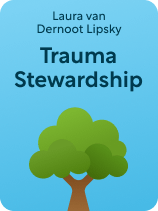

This article is an excerpt from the Shortform book guide to "Trauma Stewardship" by Laura van Dernoot Lipsky. Shortform has the world's best summaries and analyses of books you should be reading.
Like this article? Sign up for a free trial here.
Do you struggle with detaching from work after you’ve gone home? How can you have a healthy work-life balance?
When you clock out from the job, it’s time to leave the work behind. Your home should be the place where you unwind and relax, not where you need to stress about work.
Continue reading to learn how to have a work-life balance that’s right for you.
What Is a Healthy Work-Life Balance?
While laboring until complete exhaustion and dedicating every second of time to your cause might feel like the best way to make a difference, Trauma Stewardship by Laura van Dernoot Lipsky argues that this is not the case. To properly care for others, she argues, you must know how to have a work-life balance—one in which you give yourself time and space to rest and renew.
(Shortform note: While Lipsky encourages finding balance and establishing hard boundaries between yourself and your work, Kim Scott argues that you should integrate your work and life instead. In Radical Candor, she explains that a balance implies that work takes energy from your personal life while taking personal time drains the energy you devote to work. Integration, on the other hand, means that your work life and your personal life enhance one another—you devote yourself to work so you can better relax at home, and you relax at home so you can better devote yourself to your work.)
Lipsky offers several tips for how to create a healthier work-life balance:
1. Encourage healthier work habits. Reflect on whether your work schedule is reasonable and consider how you can better care for the well-being of you and your coworkers. For example, make commitments with your coworkers to take breaks for lunch instead of eating in front of your computers.
(Shortform note: To determine whether your work schedule is reasonable, pause and pay attention to your feelings. Often, trauma workers are so busy that they don’t have time to reflect on how overburdened they are. When you pause and tune into your emotions, any negative feelings that you have might point to what’s currently not working for you at your job, such as an unreasonable workload or schedule. Then, you can reconsider your priorities and implement changes to how you work.)
2. Take your mind off work. Reflect on your daily routine and identify times when you can disengage from work and check in with your needs and feelings—for example, while you’re boiling a cup of tea. Additionally, build up your life outside of work by engaging in new hobbies, interacting with supportive people, and making a conscious effort not to check your devices. By taking time to recharge your physical and emotional batteries, you’ll be more effective when you’re at work.
(Shortform note: To prevent your work from seeping into your personal life, experts suggest you create a starting and ending routine to help you transition into and out of work. Establish an activity to do every day before work, such as getting in a quick exercise or meditation session, that signals your brain that it’s time for work. Then, before you leave work, create a wrap-up routine, such as reviewing and closing your to-do list, that reminds you to intentionally detach from work once your routine is done.)
3. Practice gratitude. Even during routine tasks like microwaving a meal, recognize opportunities to express your gratitude. Negative emotions like irritation and disappointment are natural when you’re exposed to suffering. While valid, harboring these emotions can harm your well-being and hinder your work. By practicing more gratitude, you can increase your resilience and make work feel more fulfilling rather than draining.
(Shortform note: While Lipsky writes that you can always identify something to be grateful for, some say it’s perfectly acceptable not to be grateful all the time. If you suppress your negative emotions and force yourself to be grateful, you succumb to toxic positivity—the belief that you should be positive no matter what. Some studies show that gratitude reduces depressive and anxious symptoms less than once believed. Experts suggest you practice gratitude if it works for you, but focus on improving your well-being in other ways if it doesn’t.)
4. Process your pain and emotions. To approach your work in a healthier way, acknowledge and find a way to process your negative emotions. Lipsky explains that people who do trauma work often absorb the pain and suffering of others. However, if you hold on to these feelings, your mental, emotional, and physical health will suffer. To process your emotions, Lipsky recommends you practice mindful activities—ones in which you’re focused on the present moment—such as meditation, physical exercise, creative hobbies, or going out into nature. When you practice mindful activities, you allow yourself space to think about, acknowledge, and release negative energy instead of letting them build up inside you.
(Shortform note: Repressing negative emotions may be just as harmful as holding onto them. Both approaches result in greater emotional pain. According to physician Gabor Maté, when we repress our emotions, we prevent ourselves from being able to recognize how much stress we’re under. In When the Body Says No, he elaborates that stress causes various diseases including cancer, and if we’re unable to recognize the stress we’re under, we remain susceptible to more illnesses. Like Lipsky, Maté advises you to acknowledge all feelings, not just positive ones, and tune in to your body for signs of stress such as a fast heart rate, excessive sweating, headaches or back pain, or digestion problems.)

———End of Preview———
Like what you just read? Read the rest of the world's best book summary and analysis of Laura van Dernoot Lipsky's "Trauma Stewardship" at Shortform.
Here's what you'll find in our full Trauma Stewardship summary:
- That the best way to care for others is to care for yourself
- How trauma damages the caregivers who are exposed to others' trauma
- How caregivers can manage secondary trauma to better support others






